Louis Weissbein | |
|---|---|
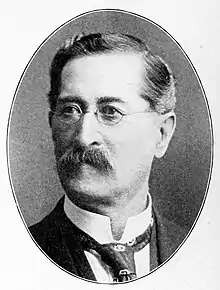 Louis Weissbein, circa 1903 | |
| Born | July 19, 1831 |
| Died | December 10, 1913 (aged 82) |
| Nationality | German |
| Occupation | Architect |
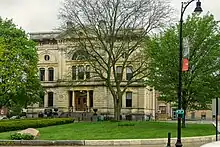

Louis Weissbein (1831-1913) was a German-born American architect practicing in Boston, Massachusetts.
Life and career
Louis Weissbein was born July 19, 1831, to Michael A. Weissbein and Johanna (Basch) Weissbein in Krotoschin, then under the control of Prussia but historically and presently a part of Poland. He was educated in a local school and studied with a government architect, followed by two years at the Bauakademie in Berlin. In 1854 he immigrated to the United States, settling in Boston.[1][2] For four years he worked as a draftsman for various architects, including Richard Bond and Nathaniel J. Bradlee.[1][3] In 1858 he established his own office in Boston. He was a sole practitioner until 1883, when he formed a partnership with William Hatch Jones,[lower-alpha 1] who had joined Weissbein as a draftsman circa 1869.[1][4] The firm of Weissbein & Jones was active until Jones' death in 1903. Weissbein then returned to private practice, retiring shortly before his death.
Weissbein was a Republican.[1] During his term as Mayor of Boston, Hugh O'Brien proposed to appoint him City Architect of Boston, though he declined. In 1891 he was appointed to the Board of Commissioners of Prisons by Governor William E. Russell, and he resigned in 1894.[5][6] Weissbein was a member of the American Institute of Architects from 1870 until 1895, and became a Fellow in 1889.[7]
Personal life
Weissbein was Jewish, and may have been the first Jewish architect to practice in Boston.[8] He was one of the best-known German residents of Boston, and was a leader in local German society and philanthropy.[1] For fifty years he was a member of the Orpheus Musical Society, a German singing society, and was president for twenty two years.[9]
Weissbein never married. He died December 10, 1913, in Boston.[10] At his death he bequeathed four thousand dollars to the Massachusetts Institute of Technology to support scholarships for Jewish students.[11]
Legacy
Weissbein's major works include the original buildings of Boston College and Temple Israel, the latter of which is the oldest synagogue building in Massachusetts. He also designed a concentration of large buildings, including the courthouse, in Pittsfield, Massachusetts, one of which has been listed on the United States National Register of Historic Places. Many of his other works contribute to listed historic districts.
Weissbein established the Louis Weissbeing Scholarship Fund (1915) at the Massachusetts Institute of Technology "to found a scholarship to be awarded each year to a promising student, preference to be given a Jewish boy in making the award."[12]
Architectural works
- Boston College (former),[lower-alpha 2] 761 Harrison Ave, Boston, Massachusetts (1858–60)[13]
- Washington Building,[lower-alpha 3] 387 Washington St, Boston, Massachusetts (1859, demolished)[14][10]
- Public Library of Brookline, 361 Washington St, Brookline, Massachusetts (1866–69, demolished)[15]
- House for Louis Prang,[lower-alpha 4] 29 Centre St, Roxbury, Boston, Massachusetts (1867)[16][17]
- L. Prang & Company factory,[lower-alpha 4] 1 Gardner St, Roxbury, Boston, Massachusetts (1867 et seq)[16][17]
- Berkshire Life Insurance Company Building,[lower-alpha 5] 5 North St, Pittsfield, Massachusetts (1868, altered 1911, NRHP 1986)[18]
- Berkshire County Courthouse,[lower-alpha 5] 76 East St, Pittsfield, Massachusetts (1869–71, altered 1908)[19]
- Berkshire County House of Correction, 264 2nd St, Pittsfield, Massachusetts (1869–71)[20]
- Fire Station No. 1, 140 Washington St, Brookline, Massachusetts (1870–71, demolished 1907)[21]
- Academy of Music, 160-196 North St, Pittsfield, Massachusetts (1872, burned 1912)[22]
- Four houses for George Wheatland Jr.,[lower-alpha 6] 225, 227, 229 and 231 Marlborough St, Boston, Massachusetts (1873–74)[23]
- Dudley School, Roxbury, Boston, Massachusetts (1874, demolished)[24]
- Hotel Comfort,[lower-alpha 7] 10 Williams St, Roxbury, Boston, Massachusetts (1877–78)[13]
- House for Henry Schreiber,[lower-alpha 8] 175 Poplar St, Roslindale, Boston, Massachusetts (1879)[25]
- Morse Block, 58-72 South St, Boston, Massachusetts (1880–83, demolished)[26]
- House for J. Avery Richards,[lower-alpha 6] 103 Newbury St, Boston, Massachusetts (1881, altered)[27]
- Blake and Osborne Building,[lower-alpha 9] 118 South St, Boston, Massachusetts (1883)[13]
- House for Leopold Morse,[lower-alpha 6] Boston, Massachusetts (1884–85, altered 1929)[28]
- Hecht Building, 207-209 Federal St, Boston, Massachusetts (1885–86, burned 1893)[26]
- Hotel Dunbar,[lower-alpha 10] 2401 Washington St, Roxbury, Boston, Massachusetts (1885–86, burned 1982)[26][29]
- Temple Israel (former),[lower-alpha 11] 600 Columbus Ave, Boston, Massachusetts (1885)[8]
- Soldiers' Home addition, Chelsea, Massachusetts (1889–90, demolished)[31]
- Waterman Block,[lower-alpha 7] 2328 Washington St, Roxbury, Boston, Massachusetts (1890)[13]
- Elysium Club, 218 Huntington Ave, Boston, Massachusetts (1891, demolished)[8]
- Hecht Building, 207-221 Federal St, Boston, Massachusetts (1893, demolished)[26]
- W. L. Lockhart & Company factory,[lower-alpha 12] 120 1st St, Cambridge, Massachusetts (1902, demolished)[32]
Gallery of architectural works
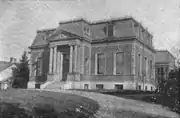 Public Library of Brookline, Brookline, Massachusetts, 1866-69.
Public Library of Brookline, Brookline, Massachusetts, 1866-69.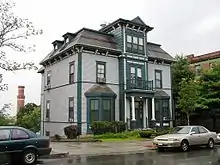 House for Louis Prang, Roxbury, Boston, Massachusetts, 1867.
House for Louis Prang, Roxbury, Boston, Massachusetts, 1867.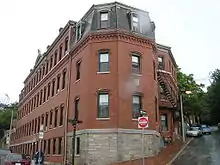 L. Prang & Company factory, Roxbury, Boston, Massachusetts, 1867 et seq.
L. Prang & Company factory, Roxbury, Boston, Massachusetts, 1867 et seq.
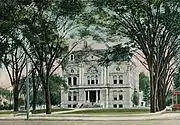 Berkshire County Courthouse, Pittsfield, Massachusetts, 1869-71, prior to alterations.
Berkshire County Courthouse, Pittsfield, Massachusetts, 1869-71, prior to alterations..png.webp) Soldiers' Home addition, Chelsea, Massachusetts, 1889-90.
Soldiers' Home addition, Chelsea, Massachusetts, 1889-90..jpg.webp) Hecht Building, Boston, Massachusetts, 1893.
Hecht Building, Boston, Massachusetts, 1893.
Notes
- ↑ William Hatch Jones was born March 3, 1841 in Roxbury. He served in the Union Army for the full duration of the Civil War. He worked as a draftsman in several offices before and after the war before joining Weissbein. After the war he continued to be prominent in military affairs. He died January 14, 1903 in Roxbury.
- ↑ A contributing property to the South End District, listed on the National Register of Historic Places in 1973.
- ↑ Designed in association with architect James H. Rand. Weissbein's obituary indicated that this was the first six-story commercial building in Boston.[10]
- 1 2 A contributing property to the Roxbury Highlands Historic District, listed on the National Register of Historic Places in 1989.
- 1 2 A contributing property to the Park Square Historic District, listed on the National Register of Historic Places in 1975.
- 1 2 3 A contributing property to the Back Bay Historic District, listed on the National Register of Historic Places in 1973.
- 1 2 A contributing property to the Dudley Station Historic District, listed on the National Register of Historic Places in 1985.
- ↑ This house was briefly owned by Mary Baker Eddy, who lived in the house in 1891.
- ↑ A contributing property to the Leather District, listed on the National Register of Historic Places in 1983.
- ↑ Later known as the Bartlett Building.
- ↑ This was the second purpose-built synagogue building in Massachusetts, and the oldest still standing. Since 1903 this building has been the Columbus Avenue AME Zion Church.[30]
- ↑ Later consolidated into the National Casket Company.
References
- 1 2 3 4 5 Who's Who in New England, ed. Albert Nelson Marquis (Chicago: A. N. Marquis & Company, 1909): 985.
- ↑ Death certificate, 1913.
- ↑ Boston directories
- ↑ Louis Weissbein, Back Bay Houses.
- ↑ "Weissbein Succeeds Fitz" in Boston Daily Globe, April 23, 1891, 10.
- ↑ "Gen. Bridges Resigns" in Boston Daily Globe, January 4, 1894, 1.
- ↑ Louis Weissbein, AIA Historical Directory of American Architects.
- 1 2 3 David Kaufman, "Temples in the American Athens: A History of the Synagogues of Boston" in The Jews of Boston, ed. Jonathan D. Sarna and Ellen Smith (Boston: Combined Jewish Philanthopies of Greater Boston, 1995): 165-207.
- ↑ "Gift For Louis Weissbein" in Boston Daily Globe, December 12, 1913, 9.
- 1 2 3 "Noted as Architect" in Boston Daily Globe, December 15, 1906, 13.
- ↑ Technology Review 16, no. 1 (January, 1914): 10.
- ↑ Massachusetts Institute of Technology Catalog Academic year 1932-33. p. 50.
- 1 2 3 4 Keith N. Morgan, Buildings of Massachusetts: Metropolitan Boston (Charlottesville: University of Virginia Press, 2009)
- ↑ "Washington Building" in Ballou's Pictorial 17, no. 25 (December 17, 1859): 385.
- ↑ Kenneth A. Breisch, Henry Hobson Richardson and the Small Public Library in America (Cambridge: MIT Press, 1997)
- 1 2 Illustrated Boston (New York: American Publishing and Engraving Company, 1889): 115.
- 1 2 Historic Area Detail: BOS.RC, Massachusetts Cultural Resource Information System.
- ↑ Historic Building Detail: PIT.102, Massachusetts Cultural Resource Information System.
- ↑ Historic Building Detail: PIT.101, Massachusetts Cultural Resource Information System.
- ↑ Historic Building Detail: PIT.172, Massachusetts Cultural Resource Information System.
- ↑ History of the Brookline Fire Department, Brookline Firefighters Association.
- ↑ Edward Boltwood, The History of Pittsfield, Massachusetts; from the Year 1876 to the Year 1916 (Pittsfield: City of Pittsfield, 1916)
- ↑ 225 Marlborough, Back Bay Houses.
- ↑ "Intelligence," Massachusetts Teacher 27, no. 11 (November 1874): 462.
- ↑ Adam Gaffin, "Roslindale residents to seek landmark status for house Mary Baker Eddy once lived in," Universal Hub, June 18, 2016.
- 1 2 3 4 Charles S. Damrell, A Half Century of Boston's Building (Boston: Louis P. Hager, 1895)
- ↑ Historic Building Detail: BOS.3735, Massachusetts Cultural Resource Information System.
- ↑ 203 Commonwealth, Back Bay Houses.
- ↑ Andrew Elder and Jeremy C. Fox, Boston's Orange Line (Charleston: Arcadia Publishing, 2013)
- ↑ Our History, Columbus Avenue AME Zion Church.
- ↑ Report of the Auditor of Accounts of the Commonwealth of Massachusetts for the Year ending December 31, 1889 (Boston: Commonwealth of Massachusetts, 1890)
- ↑ "Real Estate and Building" in Cambridge Chronicle, August 23, 1902, 1.